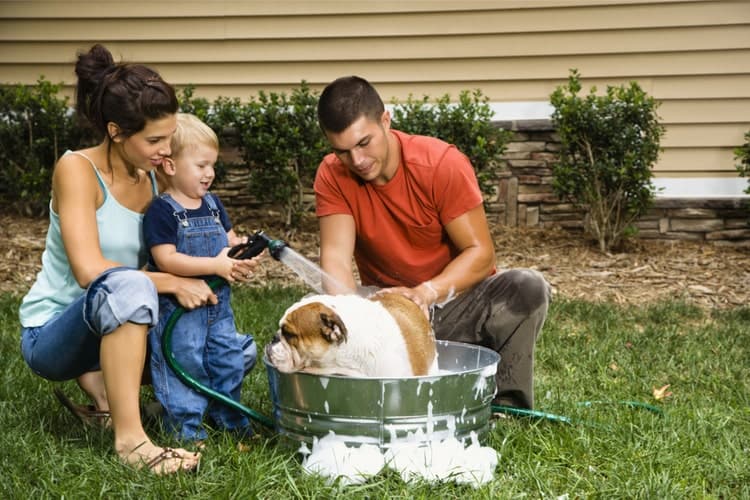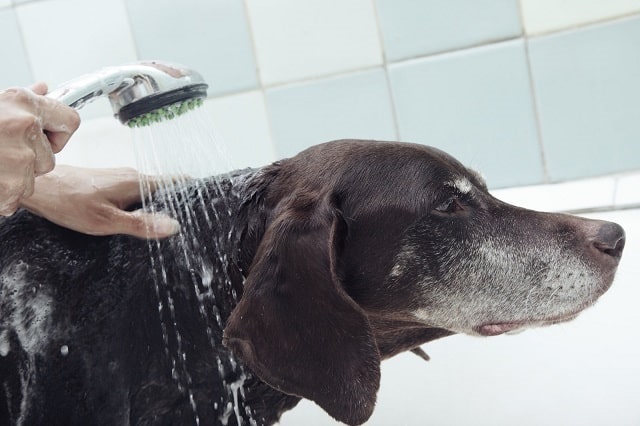Giving a dog a bath sounds easy enough, right? Just take them out back and hose them off, squirt some of your own shampoo on them, and rinse. Ta da! But wait – there actually is a right and wrong way to bathe your furry friend. By following these tips on how to give a dog a bath the right way you will hopefully find bath time less stressful and your dog will hopefully be feeling more refreshed and comfortable than before.
How Frequently Should I Bathe My Dog?
You should bathe your dog no more than every two weeks and ideally just once monthly. Bathing too frequently will result in stripping your dog’s skin of the beneficial oils that prevent dryness and flaking which ultimately result in itchy skin.1
If you have a new puppy or a pup who is working on housebreaking (i.e., stepping in their urine and/or feces), then it is important to frequently wash their paws to decrease the chance of disease spread (and make sure to get all of the key puppy shampoo and cleaning products by checking out our New Puppy Checklist). However, that does not mean you need to give them a full bath each time. Try to rinse just their paws or use wet wipes to keep them clean in between bathing. Additionally, if your dog has little outdoor activity, it is okay to go longer than one month between baths. If their coat appears clean and free from smells and they do not suffer from allergies or skin conditions, then going several months without a bath will likely not result in any undesirable consequences.
In general, but particularly If your dog has long hair, then daily brushing is also essential to decrease the frequency of required baths.2
Please note that animals with allergies or skin conditions may be on a more frequent bathing schedule under the advice of their veterinarian.3 If you think your pet may have allergies or a skin condition, it is best to have them evaluated by a veterinarian who can prescribe medicated shampoos, topical products, oral medications, and a long-term treatment plan for your pet.
Where Should I Bathe My Dog?
Ideally, you will bathe your dog in your bathtub or if they are small enough, in your sink. If you do not have a shower head with a hose attachment, you can find sprayer attachments or portable bet baths from various online providers. If you need to use your outdoor hose just be sure to test the water temperature before spraying your pet. You never want to pick up a hose that’s been laying in the direct sun and immediately spray your dog – this can result in severe burns.
What Supplies are Necessary?
The most important product you will need is shampoo. Do not use human or even baby shampoos on your dog as these tend to strip their coat of essential oils causing an overly dry coat or irritated skin.4
The ideal shampoo is moisturizing, so products with oatmeal, coconut oil, or aloe are preferred. An important step many owners forget is that once the shampoo is lathered up, you need to let it sit on the coat for 10-15 minutes before rinsing – this is essential!5 I recommend the product Dechra DermAllay Oatmeal Shampoo for Pets to my clients.
Conditioners are not essential but can provide some great benefits. I prefer leave-in conditioners which act to replenish the skin coat with omega-3 and omega-6 fatty acids, thereby improving the skin barrier.6
Once sprayed onto the coat, conditioners should be brushed through or manually worked into the coat. Don’t forget the armpits, groin, and in between the toes as these areas tend to get irritated through rubbing. By using a leave-in conditioner you can increase the interval between baths by two weeks. If your pet is averse to spray applications, you can always spray the conditioner onto a gauze square or paper towel and then wipe it onto their coat. Additionally, to prevent your dog from licking the product off, take them on a walk, give them a puzzle toy, or play a game with them immediately following the application to serve as a distraction. My conditioner of choice is Dermoscent Atop 7 Spray.
What Water Temperature is Preferred?
We tend to assume that our pets prefer a nice warm shower as we would, and while that might feel good to them at the time, ultimately this will result in a dry, flakey coat that can be intensely itchy and uncomfortable. The water temperature should be lukewarm to cool. Always test the water temperature on your own skin before spraying it onto your pet.
Do I Need to Dry My Dog?
Yes! You should dry your dog following a bath to prevent them from getting too cold. If it is warm outside you can towel dry your pet. If it is cold or your pet is small (less than 20 lbs) I would recommend using a dog hair dryer.
One final note is that brushing your dog prior to bathing will shorten the drying time and also make it easier to brush as wet fur mats more easily than dry fur. This important step will save you time and make bath time more comfortable for your companion.
Bathing your dog doesn’t have to be a dreaded chore for you or your furry friend. Follow these steps to give a proper bath and try your best to make it an enjoyable experience. And don’t forget, treats and praise following bath time is always an essential step!
If you’re concerned with your dog’s hygiene, you may also be interested in the best nutrition and health for your pup. We have a series of resources on those topics. Our puppy weight calculator can let you know how big your dog is likely to be, our list of human foods dogs can eat can help you figure out what’s safe to feed your dog, our guide to a healthy dog weight can help you identify different inflection points in your dog’s growth, and our collection of breed-specific growth charts can help you get a better sense of the goldendoodle average weight, great dane average weight, golden retriever average weight, chihuahua average weight, or labrador average weight.(Check our article and know more about labrador average weight)
Article Sources
Pet News Daily uses only high-quality sources, including peer-reviewed studies, to support the facts within our articles. Read our editorial process to learn more about how we fact-check and keep our content accurate, reliable, and trustworthy.
- Zabel S. Shampoo use in Veterinary Medicine. World Small Animal Veterinary Association World Congress Proceedings. Jeju, Korea: Vin.com; 2011. Accessed March 3, 2021.
- Hunter T, Yuill C. Grooming and Coat Care for Your Dog. Vcahospitals.com. Accessed March 3, 2021.
- Nash T. Treatment of canine atopic dermatitis. Banfield.com. Published March 24, 2008. Accessed March 3, 2021.
- Loria K. Allergic, parasitic, and viral skin disease treatment toolkit. Veterinarypracticenews.com. Published April 16, 2018. Accessed March 3, 2021.
- Zabel S. Shampoo use in Veterinary Medicine. World Small Animal Veterinary Association World Congress Proceedings. Jeju, Korea: Vin.com; 2011. Accessed March 3, 2021.
- Patel A. Essential fatty acids in veterinary dermatology: do they have a place? Veterinary-practice.com. Published June 1, 2017. Accessed March 3, 2021.


